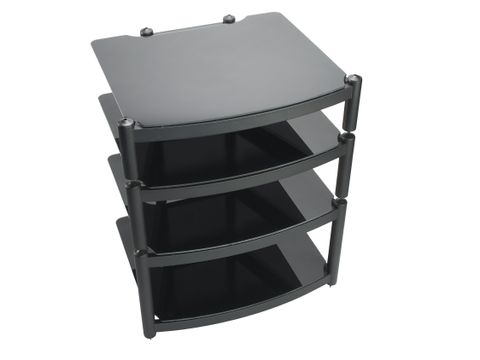TechRadar Verdict
A tough and versatile stand that adds a slight presence bloom to the sound, well suited to large and heavy kit
Pros
- +
Sturdy and easy to dismantle
Cons
- -
Quite difficult to set up
Why you can trust TechRadar
Atacama has been in the equipment supports game for a very long time, and the experience has clearly come in useful when designing the Equinox XL Pro SE.
This model neatly marries 'old-time' virtues of rigidity and tubular-welded construction with modern curves and 'designer' looks. The Equinox range includes several versions of the stand, and this one is aimed at particularly wide equipment.
Its four-leg design (the 'Hi-Fi' model has only three) aids balance and load-carrying, although it's intrinsically trickier to set up and level.
The base unit supports two shelves, with add-on units supplied separately. The base rests on spikes, and individual levels connect to one another using spikes too, making the stand easily to dismantle, but also secure and steady.
The toughened glass shelves rest on ball-bearings, sandwiched between plastic locating cups to prevent the shelves from sliding too readily. If you really value point-contact support you could leave out the upper cups, but having glass on ball bearings means it is a bit inclined to skid every time you press a button!
Not surprisingly, the assembly is on the resonant side and this has a noticeable effect on the system. It's not too severe, though, and the slight degree of presence enhancement it gives can sound downright pleasant with some systems.
The size is generous enough to support a variety of outsize kit (not extra-deep Krell amps though!), plus it looks dead smart.
Tech.co.uk was the former name of TechRadar.com. Its staff were at the forefront of the digital publishing revolution, and spearheaded the move to bring consumer technology journalism to its natural home – online. Many of the current TechRadar staff started life a Tech.co.uk staff writer, covering everything from the emerging smartphone market to the evolving market of personal computers. Think of it as the building blocks of the TechRadar you love today.

Amazon Prime Video's disappearing act could point to a future without the service

Tesla Cybertruck suffers new recall for a very scary problem

'The party is over for developers looking for AI freebies' — Google terminates Gemini API free access within months amidst rumors that it could charge for AI search queries
